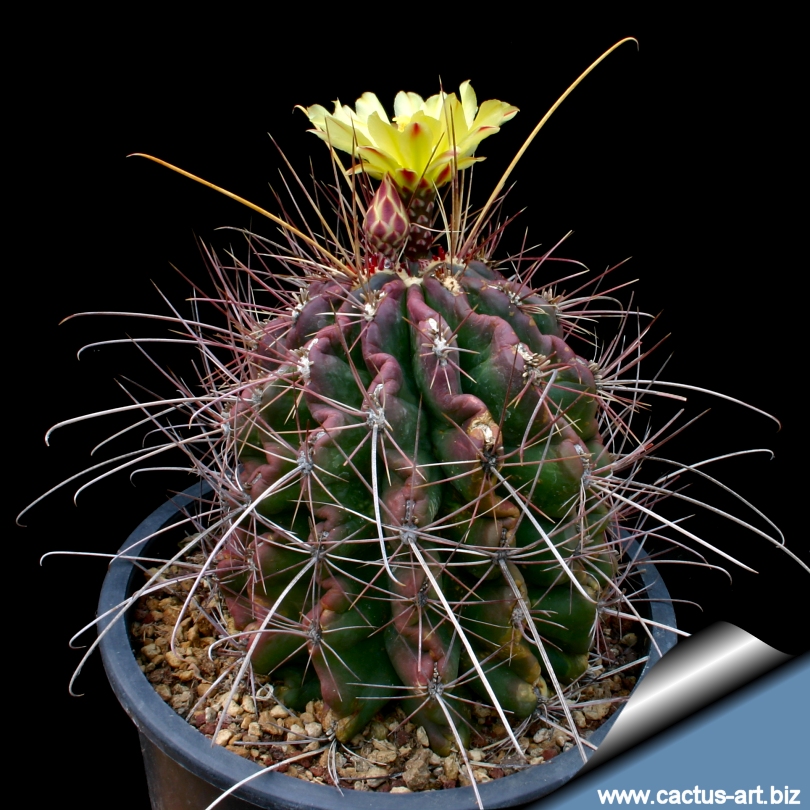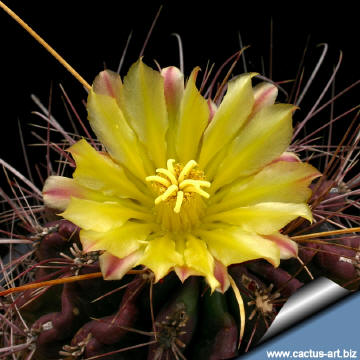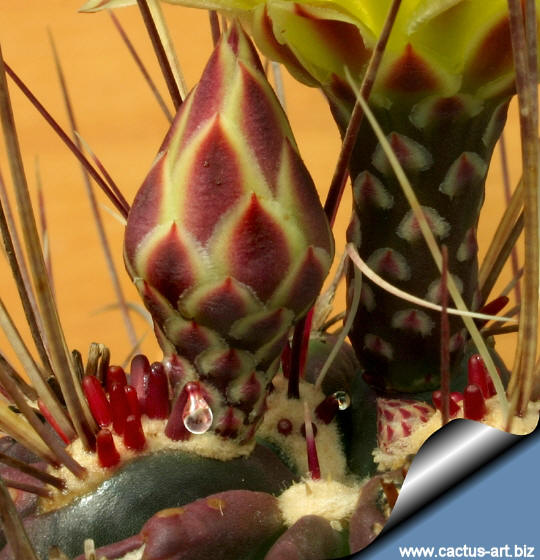|
|
|

Hamatocactus longihamatus
|
 |
Description:
Solitary, or sparsely clumping
Stems: Spheric to ovoid, dark green 10-30 × 7.5-20 cm.
Ribs: typically 13 ( to 17), undulate to deeply crenate,
tuberculate.
Areoles: 1-3 cm apart , young ones with yellow felt. The
areolar gland are numerous bright red up to 1 cm long.
Spines: 12-16 per areole; Central spines up to 4 per areole,
curved or slighly
hooked, principal
central spine thin s± flattened, 5-10 cm × 0,4--3 mm, ± flexible.
Flowers: Pale yellow 6-7.5 × 7-9 cm; stigma lobes 8-10.
Fruits: Green, yellow-green, or olive, 20-45 × 10-35 mm.
Seeds: ca. 1 mm.
Blooming season: Early summer to autumn
in succession.
|
|
Cultivation: This species is easy and
well worth growing. Require little care once they have
reached a nice flowering size. H. simuatus is suited for any
rich, well drained soil in full sun throughout the year
(But do better with some light shade in summer). Pot
culture: grow best in a well-drained container filled with a
porous cactus soil mixture that doesn't contain too much humus. To
insure robust plants water and fertilize during the aestival growth
cycle, this plant need plenty of water (indicatively to about once a
week) But needs to be avoided wetting the bodies of these plants while
they are in sunlight. A wet cactus in the sun light can cause sun
burning which can lead to scares or even fungal infections and death.
Care must be taken to prevent
sooty
mould forming on the sugary
secretions from near the
areoles.
Frost Tolerance: In winter keep completely dry at
5°C this usually aids in maintaining a healthier plant, but
it is hardy to -7°C.
nts belonging to the Ferocactus hamatacanthus (H.
sinuatus)
complex. (This
Taxon has lots of
synonyms whit several controversial varieties and subspecies:
|
|
Advertising
|
|
|
|
|
Family:
Cactaceae (Cactus
Family)
Hamatocactus longihamatus
|
|
Scientific Name:
Ferocactus
hamatacanthus var. hamatacanthus (Muehlpf.) Britton & Rose
Common Name: Turk's head
Conservation status: Listed in
CITES Appendix II
|
Synonyms:
- Ferocactus
hamatacanthus ssp. hamatacanthus
- Ferocactus
hamatacanthus var. crassispinus
- Echinocactus
longihamatus
- Echinocactus
longihamatus var. crassispinus
- Hamatocactus
hamatacanthus
- Bisnaga hamatacantha
- Echinocactus
hamatocanthus
- Echinocactus sinuatus
|
|
|
|

The
nectaries with a drop of
nectar |
|
Reproduction: Seeds or
cutting. Seeds are the typical way of reproducing. These
cacti will easily grow from seeds and some from cuttings. Seeds can be
sown in the spring or summer in well-drained pots of soil for cacti and
sow the seeds thinly on top. Cover them with a bit of fine quartz grit.
Moisten and lay a piece of glass across the top. The pots should be set
in a warm greenhouse until they start to sprout after which the glass
should be progressively removed so they can receive full light and air.
It isn't good to keep the glass over the seedlings. The seedlings well
developed can be planted separately in small pots.
Cuttings made from pieces of the stem of any size can be detached and
laid aside for a few days to allow a protective "skin" to form over the
cut. They can then be planted in pots. Place them in a spot where
they'll receive sun and do not water until the soil becomes fairly dry.
After a while the soil can be moistened regularly but never kept
constantly saturated.
|
|
Photo of conspecific taxa, varieties, forms and cultivars of
pla


|
|